Image quality
While astigmatism remains present in the Wright camera, it combines with the mirror's Petzval field curvature to result in a flat best image surface. In effect, the only monochromatic fourth order (wavefront) aberration of the Wright camera is relatively strong astigmatism.
In terms of the wavefront error, the flat-field P–V errors are identical in both, Schmidt and Wright camera, given by W=h2/16DF3 (h being the height in the image plane, D the aperture diameter and F the focal ratio number).
However, while the off-axis error in the flat-field Schmidt results from defocus, in the Wright camera it is caused by astigmatism. Since the RMS/P–V error ratio is smaller by a factor of 0.51/2 for astigmatism, the actual quality flat-field radius in the latter is larger by a factor of 1.4.
On the other hand, the best (curved) image surface of the Schmidt is practically free from off-axis aberrations, hence clearly superior in quality to a best (flat) field in the Wright camera. Also, since the Wright camera requires twice as strong corrector to cancel spherical aberration of the mirror, its chromatic error is double that in a comparable Schmidt camera.
Both, more strongly aspherized corrector and, especially, strongly aspherized fast mirror (into a rather unpopular type of aspheric shape) of the Wright are a fabrication disadvantage. On the plus side, the Wright camera is only about half as long as an equivalent diameter Schmidt. Also, since the corrector in Wright's arrangement nearly coincides with the image plane, it can support the film/detector assembly, clearing the optical path from supporting vanes.
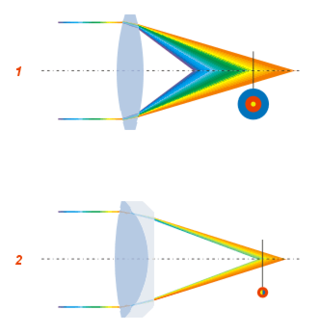
In optics, aberration is a property of optical systems, such as lenses, that causes light to be spread out over some region of space rather than focused to a point. Aberrations cause the image formed by a lens to be blurred or distorted, with the nature of the distortion depending on the type of aberration. Aberration can be defined as a departure of the performance of an optical system from the predictions of paraxial optics. In an imaging system, it occurs when light from one point of an object does not converge into a single point after transmission through the system. Aberrations occur because the simple paraxial theory is not a completely accurate model of the effect of an optical system on light, rather than due to flaws in the optical elements.
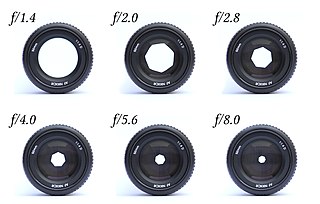
In optics, the aperture of an optical system is a hole or an opening that primarily limits light propagated through the system. More specifically, the entrance pupil as the front side image of the aperture and focal length of an optical system determine the cone angle of a bundle of rays that comes to a focus in the image plane.

A Ritchey–Chrétien telescope is a specialized variant of the Cassegrain telescope that has a hyperbolic primary mirror and a hyperbolic secondary mirror designed to eliminate off-axis optical errors (coma). The RCT has a wider field of view free of optical errors compared to a more traditional reflecting telescope configuration. Since the mid 20th century, a majority of large professional research telescopes have been Ritchey–Chrétien configurations; some well-known examples are the Hubble Space Telescope, the Keck telescopes and the ESO Very Large Telescope.

Adaptive optics (AO) is a technique of precisely deforming a mirror in order to compensate for light distortion. It is used in astronomical telescopes and laser communication systems to remove the effects of atmospheric distortion, in microscopy, optical fabrication and in retinal imaging systems to reduce optical aberrations. Adaptive optics works by measuring the distortions in a wavefront and compensating for them with a device that corrects those errors such as a deformable mirror or a liquid crystal array.

An optical telescope is a telescope that gathers and focuses light mainly from the visible part of the electromagnetic spectrum, to create a magnified image for direct visual inspection, to make a photograph, or to collect data through electronic image sensors.

A reflecting telescope is a telescope that uses a single or a combination of curved mirrors that reflect light and form an image. The reflecting telescope was invented in the 17th century by Isaac Newton as an alternative to the refracting telescope which, at that time, was a design that suffered from severe chromatic aberration. Although reflecting telescopes produce other types of optical aberrations, it is a design that allows for very large diameter objectives. Almost all of the major telescopes used in astronomy research are reflectors. Many variant forms are in use and some employ extra optical elements to improve image quality or place the image in a mechanically advantageous position. Since reflecting telescopes use mirrors, the design is sometimes referred to as a catoptric telescope.

The Newtonian telescope, also called the Newtonian reflector or just a Newtonian, is a type of reflecting telescope invented by the English scientist Sir Isaac Newton, using a concave primary mirror and a flat diagonal secondary mirror. Newton's first reflecting telescope was completed in 1668 and is the earliest known functional reflecting telescope. The Newtonian telescope's simple design has made it very popular with amateur telescope makers.

An optical system with astigmatism is one where rays that propagate in two perpendicular planes have different foci. If an optical system with astigmatism is used to form an image of a cross, the vertical and horizontal lines will be in sharp focus at two different distances. The term comes from the Greek α- (a-) meaning "without" and στίγμα (stigma), "a mark, spot, puncture".

A Schmidt camera, also referred to as the Schmidt telescope, is a catadioptric astrophotographic telescope designed to provide wide fields of view with limited aberrations. The design was invented by Bernhard Schmidt in 1930.
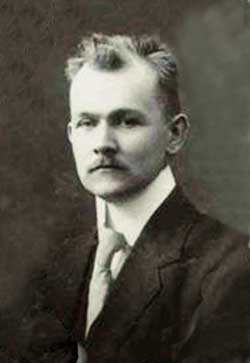
Bernhard Woldemar Schmidt was an Estonian optician. In 1930 he invented the Schmidt telescope, which corrected for the optical errors of spherical aberration, coma, and astigmatism, making possible for the first time the construction of very large, wide-angled reflective cameras of short exposure time for astronomical research.

A catadioptric optical system is one where refraction and reflection are combined in an optical system, usually via lenses (dioptrics) and curved mirrors (catoptrics). Catadioptric combinations are used in focusing systems such as searchlights, headlamps, early lighthouse focusing systems, optical telescopes, microscopes, and telephoto lenses. Other optical systems that use lenses and mirrors are also referred to as "catadioptric", such as surveillance catadioptric sensors.

The Maksutov is a catadioptric telescope design that combines a spherical mirror with a weakly negative meniscus lens in a design that takes advantage of all the surfaces being nearly "spherically symmetrical". The negative lens is usually full diameter and placed at the entrance pupil of the telescope. The design corrects the problems of off-axis aberrations such as coma found in reflecting telescopes while also correcting chromatic aberration. It was patented in 1941 by Soviet optician Dmitri Dmitrievich Maksutov. Maksutov based his design on the idea behind the Schmidt camera of using the spherical errors of a negative lens to correct the opposite errors in a spherical primary mirror. The design is most commonly seen in a Cassegrain variation, with an integrated secondary, that can use all-spherical elements, thereby simplifying fabrication. Maksutov telescopes have been sold on the amateur market since the 1950s.
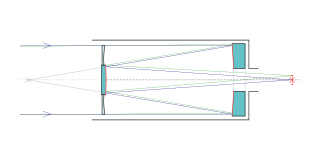
The Schmidt–Cassegrain is a catadioptric telescope that combines a Cassegrain reflector's optical path with a Schmidt corrector plate to make a compact astronomical instrument that uses simple spherical surfaces.

The Cassegrain reflector is a combination of a primary concave mirror and a secondary convex mirror, often used in optical telescopes and radio antennas, the main characteristic being that the optical path folds back onto itself, relative to the optical system's primary mirror entrance aperture. This design puts the focal point at a convenient location behind the primary mirror and the convex secondary adds a telephoto effect creating a much longer focal length in a mechanically short system.
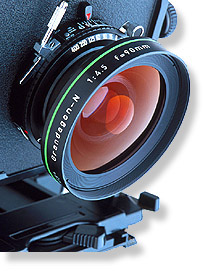
Large format lenses are photographic optics that provide an image circle large enough to cover the large format film or plates used in large format cameras.

An aspheric lens or asphere is a lens whose surface profiles are not portions of a sphere or cylinder. In photography, a lens assembly that includes an aspheric element is often called an aspherical lens.
The Strehl ratio is a measure of the quality of optical image formation, originally proposed by Karl Strehl, after whom the term is named. Used variously in situations where optical resolution is compromised due to lens aberrations or due to imaging through the turbulent atmosphere, the Strehl ratio has a value between 0 and 1, with a hypothetical, perfectly unaberrated optical system having a Strehl ratio of 1.
The design of photographic lenses for use in still or cine cameras is intended to produce a lens that yields the most acceptable rendition of the subject being photographed within a range of constraints that include cost, weight and materials. For many other optical devices such as telescopes, microscopes and theodolites where the visual image is observed but often not recorded the design can often be significantly simpler than is the case in a camera where every image is captured on film or image sensor and can be subject to detailed scrutiny at a later stage. Photographic lenses also include those used in enlargers and projectors.
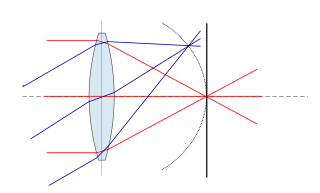
Petzval field curvature, named for Joseph Petzval, describes the optical aberration in which a flat object normal to the optical axis cannot be brought properly into focus on a flat image plane. Field curvature can be corrected with the use of a field flattener, designs can also incorporate a curved focal plane like in the case of the human eye in order to improve image quality at the focal surface.

A three-mirror anastigmat is an anastigmat telescope built with three curved mirrors, enabling it to minimize all three main optical aberrations – spherical aberration, coma, and astigmatism. This is primarily used to enable wide fields of view, much larger than possible with telescopes with just one or two curved surfaces.
















